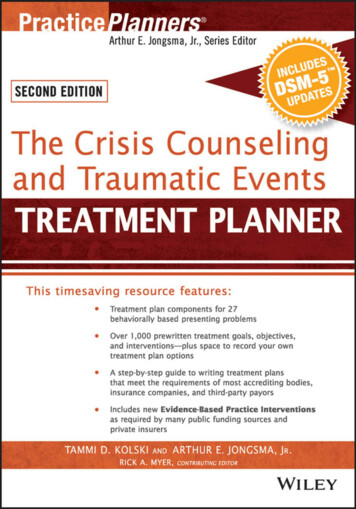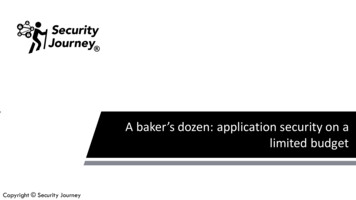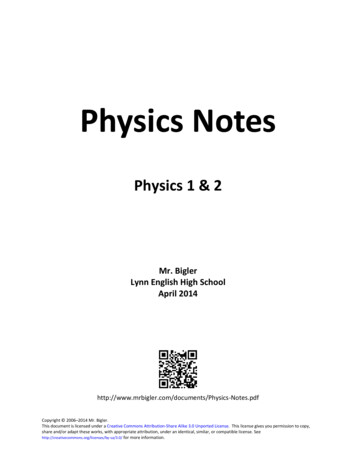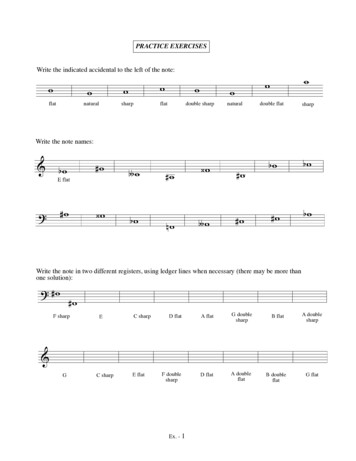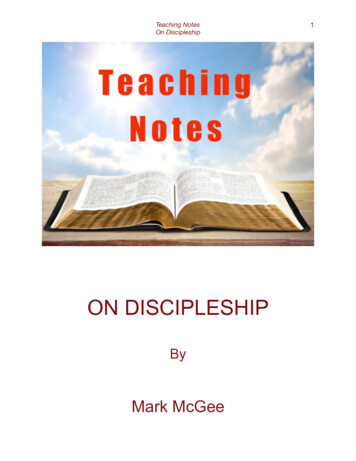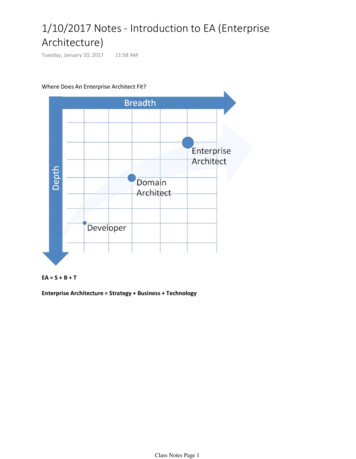
Transcription
1/10/2017 Notes - Introduction to EA (EnterpriseArchitecture)Tuesday, January 10, 201711:58 AMWhere Does An Enterprise Architect Fit?EA S B TEnterprise Architecture Strategy Business TechnologyClass Notes Page 1
Key Term: EA(Enterprise Architecture) is a strategy and business-driven activity that supportsmanagement planning and decision-making by providing coordinated views of an entire enterprise.Key Term: Enterprise An organization or sub-activity whose boundary is defined by commonly-heldgoals, processes, and resources. This includes whole organizations in the public, private, or non-profitsectors, part(s) of an organization such as business units, programs, and systems, or part(s) of multipleorganizations such as consortia and supply chains.Class Notes Page 2
Key Term: Enterprise Architecture The analysis and documentation of an enterprise in its current andfuture states from an integrated strategy, business, and technology perspective.Class Notes Page 3
1/12/2017 Notes - The Six Elements of EnterpriseArchitectureThursday, January 12, 201711:50 AMGovernance Principal: The person who signs the checks should not be the person whoopens the bank statementsGovernance ProcessClass Notes Page 4
Methodology: An algorithm for how to run the EA programEA3 "Cube" FrameworkClass Notes Page 5
A Question An EA Might Have To AnswerClass Notes Page 6
1/12/2017 Notes - Organizations and Leadership, And TheValue And Risk Of EAThursday, January 12, 20171:02 PMKey Term: Line of Business: A Line of Business (LOB) is a distinct area of activity within the enterprise. It may involve themanufacture of certain products, the provision of devices, or internal administrative functions.Key Term: Architecture Segment: A Part of the Overall EA that documents one or more lines of business at all levels andthreads. A segment can exist as a stand-alone part of the EA.Key Term: Vertical Component: A vertical component is a changeable goal, process, program, or resource (equipment,systems, data, etc.) that serves one line of businessKey Term: Horizontal (crosscutting) component: A horizontal (or crosscutting) component is a changeable goal, process,program, or resource that service several lines of business. Examples include email and administrative support systemsthat serve the whole enterprise.Key Term: Change Management: The process of setting expectations and involving stakeholders in how a process oractivity will be changes, so that the stakeholders have some control over the change and therefore may be moreaccepting of the changeClass Notes Page 7
Change CurveClass Notes Page 8
Class Notes Page 9
1/17/2016 Notes - Organizations and Leadership, And TheValue And Risk Of EATuesday, January 17, 201712:01 PMSometimes, Enterprise architecture is overkill- It is work to be done, which consumes resources, time, and money- The value It brings may not outweigh these costsWhat sort of value can EA bring?- Improved planning and coordination- Improved (and maybe even streamlined) decision making- Communication and enterprise awareness- Risk ManagementWhat are some of the risks EA can help manage (And even Avoid)- Financial- Lack of Acceptance- Los of Key Personnel- Schedule Days- Documentation and shared knowledge- Misalignment with corporate strategies and prioritiesClass Notes Page 10
Modelling ActivityTuesday, January 17, 20171:20 PMSITS: Sales and Inventory Tracking System- COO Kate JarvisInventoryCost TrackingBy ProductCost Accounting- COTS Commercial Off The Shelf- CFO Jim GormanSITSCIO Sam YoungThings to accomplish- Inventory Current System & practices- Identify OverlapSITSCOMMON ingGroupCOTSSalesClass Notes Page 11
1/19/2017 Notes - EA: Implementation MethodologyThursday, January 19, 201711:58 AMKey Term: EA Framework: The EA framework is a structure for organizing information the defines thescope of the architecture, what the EA program will document and the relationship of various areas ofthe architecture.Key Term: EA Methodology: The EA methodology defines how the EA will be implemented and howdocumentation will be developed, archived, and used; including the selection of a framework, modelingtools, and on-line repositoryKey Term: Executive Sponsor: The Executive who has decision-making authority over the EA programand who provides resources and senior leadership for the EA programKey Term: EA Artifact: An EA artifact is a documentation product, such as a text document, systemspecification, application interface information, diagram, spreadsheet, briefing slides, and/or video clip#6 Common ThreadsWhat Are Our Initial Considerations?- Which areas of the enterprise EA will cover (Scope)- The approach to EA governance (e.g., centralized or decentralized)- The types of EA documentation (known as artifacts) that will be needed to support business andtechnology resource planning and decision-making- The EA documentation framework that best supports the needs of the enterprise.- The methods and techniques for gathering or developing EA documentation- The software modelling tools, web applications, and databases that wil be needed to automatedocumentation techniques and enable future scenario modeling- How EA users will access and share EA documentation- How often EA documentation will be updatedFour phases, 20 stepsPhase 1 - EA Program EstablishmentClass Notes Page 12
Phase 1 - EA Program EstablishmentStep 1: Establish the EA Management Program and identify a Chief ArchitectStep 2: Establish an EA implementation methodologyStep 3: Establish EA Governance and links to other management processesStep 4: Develop an EA Communication Plan and gain stakeholder buy-inPhase 2 - EA Framework and Tool Selection- The methods and techniques for gathering or developing EA documentation- The software modeling tools, web applications, and databases that will be needed toautomate documentation techniques and enable future scenario modelingStep 5: Select a EA documentation frameworkStep 6: Identify the RA Lines of Business and Crosscuts and the order of their documentation(hence, the verticals and horizontalsStep 7: Identify the RA components to be documented- These are specific components that we will address -- each of these live in the LOBs andcrosscuts identified aboveStep 8: Select documentation methods appropriate for the framework- These are the specific methods and formats that will be used to document ( and hence,communicate) each of the componentsStep 9: Select Software applications/tools to support automated EA documentationStep 10: Select and establish an on-line EA repository for documentationPhase 3 - Documentation of the EAStep 11: Evaluate existing business and technology documentation for use in the EA.Step 12: Document current views of existing EA components in all framework areas(levels/threads). Store artifacts in the on-line repository.Step 13: Develop several future business/technology operating scenarios.Step 14: Identify future planning assumptions for each future scenario.Step 15: Use the scenarios and other program/staff input to drive the documentation of future EAcomponents in all framework areas. Store artifacts in the on-line EA repository. Step 16: Developan EA Management Plan to sequence planned changes in the EA.Phase 4 - Use and Maintain the EAStep 17: Use EA information to support planning and decision-making.Step 18: Regularly update current and future views of EA components.Step 19: Maintain an EA Repository for modeling and analysis products.Step 20: Release annual updates to the EA Management Plan.Phase 3 - Documentation of the EAPhase 4 - Use and maintain the EAWhat are examples of "Documentation Methods"?Strategic Level: Strategic Plan, Scenarios, Balanced ScorecardBusiness Level: IDEF-0 Diagrams, Flowcharts, Swim Lane ChartsInformation Level: Data Models, Object Diagrams, Data DictionaryServices Level: System Diagrams, Web Services Models, APIsClass Notes Page 13
Technology Level: Voice/Data/Video Network Diagrams/DocumentsVertical Threads: Security Diagrams, Standards, Workforce SkillsClass Notes Page 14
1/24/2017 - EA: Components and ArtifactsTuesday, January 24, 201712:28 PMKey Term: EA Artifact: An EA artifact is a documentation product, such as a text document, systemspecification, application interface information, diagram, spreadsheet, briefing slides, and/or video clipKey Term: EA Component: EA components are those 'plug and play' changeable resources that providecapabilities at each level of the framework. Examples include strategic goals and initiatives, businessservices, information flaws and data objects; information systems, web services, and softwareapplications voice/data/video/mobile networks, cable plants, equipment, and buildingsClass Notes Page 15
1/31/2017Tuesday, January 31, 201711:57 AMWhat is the current view- This is an "as-is" view of the EA- Provides documentation of the current: Strategic Goals Business Services Information Flows, IT Systems servicesProject Management Artifacts- Project Plan for projects in flight Business Cases Milestones ObjectivesInformation Level Artifacts- ER Diagrams? Maybe but will probably be "pruned" to show key binding elements across theenterprise- More Likely to show logical or abstract data models that communicate how information flows or isbound across different systemsHow do we talk about the dynamic interactions between systems?Class Notes Page 16
Class Notes Page 17
2/2/2017 Thursday, February 02, 201712:16 PMShouldn't "future" views look like just an updated current viewSort of- We will certainly use similar tools and diagrams as when we document current views- Painting a picture of the future often requires more than just diagrams and words, however!- Tools Stories Concept Drawings, videos, picturesUse casesProblem Statement 1- We are building a platform to manage health and wellness programs for a wide range of peoplethat have relationships with a wide range of customers (health plans, employers, maybe evenstate governments)- Currently: Users enroll in our system creating their own unique user ID We don’t import any data that the customer provides, so we essentially have a "walledgarden" of users that greatly simplifies integration in our system- Problem An important client wants us to import health claims data from their health plan, we wantto solve not just this problem, but do it generically so that is might work for future clientsthat want the same capabilityClass Notes Page 18
2/14/17Tuesday, February 14, 201712:05 PMHow does PM conntect to EA?Class Notes Page 19
2/16/17 Thursday, February 16, 201712:15 PMClass Notes Page 20
2/21/2017Tuesday, February 21, 201712:16 PMClass Notes Page 21
MicroservicesTuesday, February 21, 201712:16 PMCharacteristics of a Microservice Architecture- Componentization Via (Web) Services- Organized around Business Capabilities- Products not Projects- Smart Endpoints and dumb pipes- Decentralized Governance- Decentralized Data Management- Infrastructure Automation- Design for Failure- Evolutionary DesignClass Notes Page 22
- Evolutionary DesignClass Notes Page 23
2/23/2017Thursday, February 23, 201712:18 PMClass Notes Page 24
2/28/2017 - Architecting The Cloud28 February, 201712:03 PMPaaS: Platform as a ServiceClass Notes Page 25
3/7/20177 March, 201712:25Element 1 - Information Security- Design- Assurance- Authentication- AccessElement 2 - Personnel- User Authentication- Awareness Training- Procedures Training Incident simulation Disaster TestElement 3 - Operations- Risk Assessment- Component Security Testing and Evaluation- Vulnerability Remediation- Component Certification and Accreditation- Standard Operating Procedures- Disaster Recovery- Continuity of OperationsElement 4 - Physical Protection- Building Security- Network Operations Centers, Server Rooms, and wiring closets- Cables PlantsThere are myths and misperceptions about "data in the cloud"- You lose control of information security- You can't do HIPAA- You can't do PCI compliance- You can justify EU privacy lawsHow much security is required?- Target Industry- Customer Expectations- Sensitivity of data being stored- Risk tolerance- Maturity of Product- Transmission boundariesClass Notes Page 26
Key Term: EA(Enterprise Architecture) is a strategy and business-driven activity that supports management planning and decision-making by providing coordinated views of an entire enterprise. Key Term: Enterprise An organization or sub-activity whose boundary is defined by commonly-held goals, processes, and resources.






